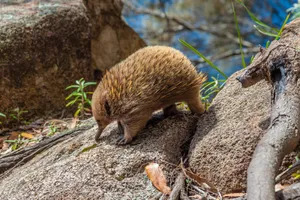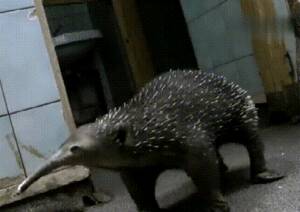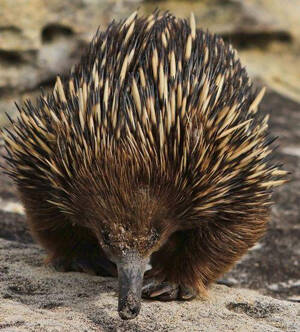Tachyglossidae
IUCN
LCBasic Information
Scientific classification
- name:Tachyglossidae
- Scientific Name:Spiny Anteater
- Outline:Monotremata
- Family:Echidna
Vital signs
- length:
- Weight:
- lifetime:
Feature
Distribution and Habitat
Appearance
Details
Echidna (Tachyglossidae), one of four peculiar egg-laying mammals found in Australia, Tasmania and New Guinea. They eat and breathe through a bald tube-like beak extending from their dome-shaped body. Covered with spines. Echidnas have round eyes and slits for ears, two small nostrils (or nostrils) at the end of their beak, and a small mouth. Electroreceptors in the skin of the beak sense electrical signals produced by the muscles of invertebrate prey. Echidnas are active day and night, exploring slowly and cautiously along the ground in search of prey, but they seek refuge from the midday heat in caves or caves. Like their close relatives, the platypus, echidnas have unusually low body temperatures, but they range from 29–32 °C (84–90 °F) and cannot tolerate more extreme temperatures. Although echidnas resemble hedgehogs in appearance, the two animals are not related and belong to different orders of mammals. Echidna species can be distinguished by their spines, the number of claws on their feet, and the shape and length of their beaks.

The short-beaked echidna (Tachyglossus aculeatus) has a straight-forward beak and thick spines. It is fairly common in suitable habitats across Australia; it is also found in New Guinea, although little is known about its range and habits. The short-beaked echidna may be Australia's most widespread native mammal, but it is only commonly found in hollow logs, bushes and caves, where it can find shelter and ample food such as ants, termites and other invertebrates. It uses its long sticky tongue to capture prey whole, but it may use its beak to tear larger soft-bodied prey into smaller pieces. Its tiny mouth can only open wide enough for its worm-like tongue to stick out.
The length of the animal's head and body, including the rudimentary tail, is usually 30-45 cm (12-18 in). Its body is covered with a combination of fur and spines (modified fur). Echidnas from colder regions, such as Tasmania, have long fur that partially covers their spines, while those from arid regions appear to be covered in spines and have no fur. Beneath the spiny skin is a well-developed layer of subcutaneous muscle, which partly explains the animal's surprising strength. This layer of muscle allows the echidna to change the contours of its thick body to wedge itself between cracks and tree roots. Echidnas can also quickly burrow themselves into the ground when disturbed. In doing so, they appear to sink directly into the soil, and once dug in, they are well camouflaged by their spines. This combination of spines, strength and strategy makes the short-beaked echidna difficult to prey on, and in fact it does enjoy a fairly predator-free existence - although wild dogs, introduced foxes and cars do occasionally pose dangers.
Heat is another danger short-beaked echidnas face. They have few sweat glands and cannot pant to dissipate excess heat; therefore, if they cannot find shady shelter, echidnas may die from heat stress. Researchers believe that the short-beaked echidna's habit of blowing bubbles of mucus out of the nostrils of its beak helps the animal regulate its body temperature: When the bubbles burst, the beak is covered with mucus, which evaporates and helps cool the body. If the temperature drops too low, torpor or hibernation can result.

Long-beaked Echidna
The western long-beaked echidna (Zaglossus bruijni) inhabits the island of New Guinea in the Indonesian province of West Papua.
The three extant species of long-beaked echidnas (genus Zaglossus) are found only on the island of New Guinea. They are usually described as being about 60 cm (24 in) long, although one individual was recorded as being 100 cm (39 in) long. . Like the short-beaked echidna, these species have highly variable fur and spine coverings. Generally speaking, their spines are much shorter and less numerous than those of short-beaked echidnas, and their fur ranges in color from medium to dark brown. The beak is also used to detect leaf litter on the forest floor for food. However, its tongue is shorter than that of the short-beaked echidna and is covered with backward-pointing barbs used for hooking earthworms.
Long-beaked echidnas live at varying altitudes, usually in forested areas, and only in sparsely populated areas. The International Union for Conservation of Nature (IUCN) Red List of Threatened Species considers all three species to be threatened, listing the eastern long-beaked echidna (Z. bartoni) as vulnerable, the western long-beaked echidna (Z. bruijnii) and the giant echidna as vulnerable. Sir David's long-beaked echidna (Z. attenboroughi) is critically endangered due to hunting (echidnas are edible) and habitat loss.
Sir David's long-beaked echidna was first scientifically described in 1999 and is about the same size as the short-beaked echidna. It is distinguished from other long-beaked echidnas by its smaller size and shorter, straighter beak, although it is otherwise similar to the echidna. Western long-beaked echidna. This species inhabits a small patch of highland forest near Jayapura, Papua, Indonesia. Currently, too little is known about Sir David's long-beaked echidna to describe its habits in detail.
The western long-beaked echidna lives in the Indonesian province of West Papua and has a pointed-down beak. Its brown fur is dotted with smaller, fewer spines than the short-beaked echidna. Western long-beaked echidnas are almost identical to eastern long-beaked echidnas; however, they are generally larger and heavier. Large Western long-beaked echidnas are typically nearly 77.5 centimeters (about 31 inches) long and can weigh up to 16.5 kilograms (about 36 pounds). By comparison, the adult weight of the eastern long-beaked echidna ranges from 4.2 to 9.1 kilograms (about 9 to 20 pounds). The number of claws on each front and rear foot can also be used to distinguish one species from another. Although the number of claws varies between individuals of the same species, Western long-beaked echidnas tend to have three claws on each foot, while eastern long-beaked echidnas tend to have five.

Reproduction and Life Cycle
Echidnas only seem to gather during the breeding season, when a female may follow a group of suitors. After a gestation period of approximately 23 days, the female typically lays a leathery egg in a temporary pouch formed by abdominal muscles and subcutaneous mammary tissue. The eggs hatch for another 10 days before hatching into tiny offspring with the help of egg teeth and fleshy bulbs (structural remnants of the creature's reptilian ancestors). The young echidna is protected in a special nursery burrow, where it sucks milk from special milk hairs (without teats and nipples). When the young echidna is completely covered in spines and fur and is able to feed, it leaves the burrow and begins a solitary life. Echidnas have a very long lifespan. One echidna in the wild has been reliably recorded to be 45 years old, while one in captivity was over 50 years old at the time of death.
Classification, evolution and paleontology
Echidnas belong to the family Limulus, and their only living relative is the platypus. Together these animals make up the order Monotremes of mammals. Echidnas likely evolved from some unknown monotreme ancestor during the Paleogene period (66 to 23 million years ago). The echidna's lack of teeth has hindered the study of its evolutionary history, as teeth are well fossilized and often help determine relationships between mammals. The oldest known echidna fossils were found in cave deposits in eastern Australia that date back about 17 million years ago (early Miocene epoch). Although the material is fragmented, it suggests that basic features of the echidna, such as a toothless, bird-like skull and a strong skeleton specialized for digging, had evolved at this time. Echidnas were once widespread and diverse, with one species being particularly large, more than 1 meter (3.3 feet) long. Most echidna fossils (genus Megalibgwilia from the most recent period) represent a form between the present-day Brachybeak and Long-beak families.






